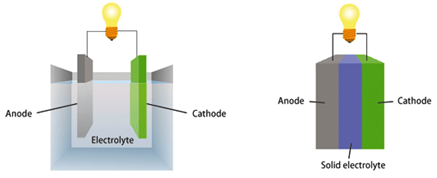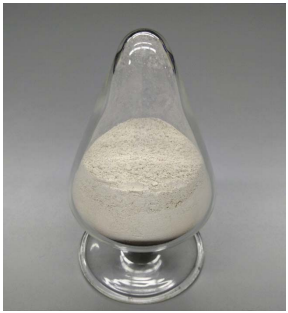Aug 2017, researchers of Japan Hitachi announced that, its solid-state battery technology has finished R&D. Relevant staff of Hitachi revealed that, Hitachi has sent the sample of solid-state battery to potential clients in aerospace and vehicle industries currently. What is more, Hitachi is now cooperating with an undisclosed Japanese battery manufacturer to improve some details’ problems, and will launch its solid-state battery in the market before 2020.
Jun 2017, a solid-state battery patent application submitted by Toyota to the United States which No. is 20170179545, was publicized. ASIACHEM research indicates that, this solid-state battery is constituted by sulfide solid electrolyte material and electrode active material. Among, constitute of the electrolyte material includes lithium, phosphorous, sulfur and iodine etc. 4 elements; cathode material includes a phosphate ester. This kind of phosphate in the cathode material is in the range of 1% to 30% by weight. By adding phosphate ester into the cathode material, thermal stability of this solid-state battery is improved. Jul, 2017, Toyota stated that, it plans to start selling EV which power is supplied by all-solid-state battery from 2022.
Solid-state lithium battery is a battery which use solid-state electrolyte. In terms of structure, solid-state lithium battery is simpler than traditional lithium ion battery. Solid-state electrolyte not only conducts lithium ions, but also plays as role of separator. In hence, in solid-state lithium battery, electrolyte, separator and PVDF, the adhesive, are no longer needed. In terms of principle of operation, solid-state lithium battery is similar with lithium ion batteries. When charging, lithium ions in cathode materials are removed from crystal lattices of active materials, and transfer to anode materials through solid-state electrolyte, while electrons transfer through external circuit. Both the lithium ions and the electrons will combine into lithium atoms, alloying or insect into anode materials. Process of discharging is opposite to process of charging. At this time, the electrons will drive the electronic devices through external circuit.

Traditional Lithium-ion Battery and Solid-State Lithium Battery Sketch Map
ASIACHEM ‘China LIB Annual Report 2017’ shows that, solid-state lithium battery choices of materials, research direction and latest progress are shown as below.
1) Electrolyte
Solid-state lithium battery mainly uses solid-state electrolyte, for example like polymer and inorganic substance. Currently, research of solid-state electrolyte mainly focuses on R&D of compound electrolyte of high conductivity.
Nov 2016, Mitsui Kinzoku released Argyrodite, all-solid-state battery used sulfide solid-state electrolyte. Mitsui Kinzoku aims to begin the commercialization of solid electrolyte in 2020, through partnerships with battery manufacturers and vehicle manufacturers.

Mitsui Kinzoku Argyrodite-type sulfide solid electrolyte
2) Cathode Material
Except traditional cathode materials, solid-state lithium battery can also compatible with oxide cathode material which voltage is higher, sulfide cathode material which volume is higher. Research directions of solid-state lithium battery cathode material focus on reducing interface impedance of cathode material and increase high rate discharge performance etc.
Aug 2015, Peking University School of Advanced Materials applied high volume Li2FeSiO4 cathode material at polyoxyethylene based all-solid-state battery. At 100℃, the battery has excellent rate performance (30C capacity has 67.5mAh/g) and quite high specific capacity play (1C capacity has 258.2mAh/g).
3) Anode Material
Except traditional graphite anode materials, solid-state lithium battery is also developing other high performance anode materials, include metal lithium, silicon-based, tin-based and oxide etc. anode materials.
May 2016, research group organized by Japan Tohoku University AIMR and Research Institute of Tokyo University announced that they have successfully developed CNAP, a new type anode material used in solid-state lithium battery. Capacity of this material is more than twice of graphite, and can remain quite high level after charging / discharging for 65 times.
Currently, many countries of the world lay down R&D targets of high energy density lithium batteries. Japanese government proposed that, power battery core energy density will reach 250Wh/kg in 2020, 500Wh/kg in 2030; United States Advanced Battery Consortium proposed that it increased core energy density in 2020 from 220Wh/kg to 350Wh/kg; China State Council ‘Made in China 2025’ proposed that, to 2020, China power battery monomer specific energy should reach 300Wh/kg, and should reach 400Wh/kg in 2025 and 500Wh/kg in 2030.
Public information shows that, currently, energy density of liquid power LIB which used ternary cathode material and graphite anode material limitation is around 280Wh/kg. If pure graphite anode material is replaced by silicon-based composite material, energy density of power LIB is expected to reach more than 300Wh/kg, and upper limit is about 350Wh/kg.
ASIACHEM believes that, power battery monomer specific energy’s targets of year 2020 proposed by above countries can be realized by current lithium-ion battery technologies. If they want to reach targets of higher energy density, solid-state lithium battery will be an important development direction. Currently, solid-state lithium battery exist overhigh interface impedance between solid-state electrolyte and cathode / anode material, solid-state electrolyte conductivity is relatively low, and material preparation cost is expensive etc. problems, which make solid-state lithium battery hard to become mainstream of market in 2022. However, considering market to lithium batteries’ energy density and safety performance requirements’ continue increasing, development prospect of solid-state lithium battery is worth expecting.